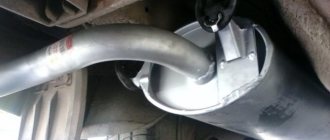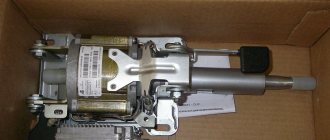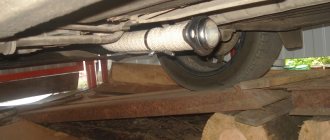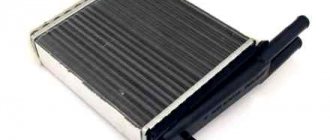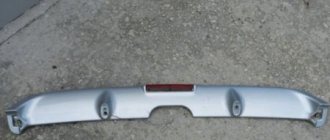In the terminology of car mechanics and drivers, the word muffler most often means the entire complex of pipes and chambers that make up the exhaust system of a modern car, hence the expression - muffler resonator.
However, this is not the case. The exhaust system of the VAZ 2114 consists of four components:
- the exhaust pipe, it is attached directly to the exhaust manifold, takes on all the main fire, chemical and vibration impacts from the exhaust gases and is therefore made only from alloyed, high-strength steel
- a catalyst, it is needed to burn excess oxygen in its chambers, which are made in the form of ceramic honeycombs, the surface of which is covered with a platinum-iridium film, upon contact with which oxidation and afterburning reaction occur and reduce the level of toxicity of passing gases
- resonator, in some sources it is called an additional muffler, but this is not a designation accepted in professional circles
- The muffler acts as residual sound absorption and removes toxic exhaust gases outside the car body
Sports resonator VAZ 2114
Why is a muffler resonator needed in a car?
After ignition occurs, gases enter the intake manifold, and then into the muffler pipes.
The resonator performs the function of reducing vehicle noise. The second, but no less important function is environmental. The resonator acts as a filter element. The operation of the exhaust system and its sound directly depend on the type, shape and size of the resonator. Failure of this part can lead to loud noise when the car engine is running, especially when the accelerator pedal is actively used, increasing engine speed.
In addition, the unpleasant smell of exhaust gases will begin to penetrate into the cabin.
Resonator device
Many car enthusiasts call the resonator a small muffler. This is explained by external features, namely the similarity with the main muffler.
Structurally, the resonator consists of a large number of layers, each of which has its own purpose. Gas entering the resonator passes through the reflectors. Thus, hot gas particles are quenched against them, dividing into two streams. In addition, the inside of the resonator is divided into two sections. A special mesh is used for this. It divides the frequency of vibrations and dampens them using friction
It is important that there is uniform pressure distribution inside the resonator so that resistance does not arise. This will ensure stable operation of the internal combustion engine, maintaining the required speed level
Types of resonators
There are two types of resonators - for two-stroke or four-stroke engines. Photo: Minsk.deal.by
There is an opinion that a resonator installed on a four-stroke engine does not provide any benefit, but only reduces the power and overall efficiency of the engine. If you remove the resonator from the exhaust system of a four-stroke engine, its power will increase by up to 15 percent. However, for the environment, such a solution will not be an advantage at all.
Installing a resonator on the exhaust system of a two-stroke engine, on the contrary, has a positive effect. Without a resonator, such an engine will consume more fuel.
Definition and purpose
The muffler resonator is a part of the vehicle's gas exhaust system. Located in the middle part of the chain and designed to extinguish exhaust gases. If the noise is excessively loud, this indicates a problem with the system.
The gas removal chain includes the following links:
- collector;
- gas receiver;
- quench catalyst;
- corrugated pipe;
- resonator.
A correctly assembled system, operating according to its proper principle, dampens almost all sounds from the exhaust manifold. Only a “whisper” is heard, although the temperature in the system reaches 300 º C. The environment is quite aggressive, so it is not so rare to change some parts or even the entire chain.
Types of designs for muffler:
- limiting;
- reflective;
- resonant;
- absorbing.
The resonating one consists of 2 or 3 pipes with holes, which are located in a common body. They create a resonance effect, leveling sound waves and pressure.
In this way, an ideal balance of pressure and resistance in the exhaust pipe is achieved.
The reasons for system failure can be various factors:
- aggressive working conditions;
- metal fatigue;
- corrosion;
- mechanical damage;
- condensate;
- chemical reaction producing acids.
All this can cause a roaring exhaust pipe. Ringing, rattling, drop in engine power due to excessive gas resistance in the system are problems in this circuit.
Replacing the resonator yourself
Exhaust system Lada Kalina sedan
To remove the resonator (additional muffler) you will need: two keys for “17” and two keys for “13”. Before dismantling, it is advisable to treat all fastening joints with a rust-dissolving agent. For example, it could be the popular WD-40.
First of all, we unscrew the clamp through which the additional muffler is connected to the main one. This process was described in more detail a little higher. Now we place some kind of stand under the catalytic converter so that after disconnecting the resonator, the catalyst does not sag and is damaged.
Now, using keys “17”, unscrew the bolts securing the additional muffler to the catalyst. Pull out the bolts and remove the additional muffler.
Installation of a new resonator is carried out in the following order:
1. When installing a new additional muffler, first fix it on the catalytic converter side. To do this, insert the bolts and tighten the nuts with several turns of thread.
2. Next, we connect the main muffler with the additional one. At the same time, we install a new graphite ring-spacer between them. It is imperative to check the tightness of the graphite gasket.
3. Place a new clamp at the connection point, and then completely tighten the bolts securing the resonator to the catalyst.
Design features
The design of the exhaust system is the same for almost all Russian cars. The example with the VAZ 2109 is typical.
Schematically, the exhaust gas exhaust system for this car looks like this:
- Reception pipe. A special probe is installed in it; the device is capable of monitoring and analyzing the composition of the mixture entering the cylinder block based on the composition of the exhaust gases.
- Next comes the catalyst. He is precisely engaged in reducing the harmfulness of exhaust gases to a minimum.
- An additional muffler is attached to the catalyst using a special clamp. The task of this muffler is to be, as they say, on the front line and take the brunt of the noise impact.
- Well, the last element is the main muffler. It is attached to the additional one using the same clamp.
How to repair a silencer with your own hands
VAZ 21124 exhaust system
The muffler on the “fourteenth” and “fifteenth” is considered one of the most vulnerable points of the car. The fact is that due to exposure to high temperatures, the metal quickly burns out, that is, the tightness of the system is broken. Therefore, the part must be changed as soon as there is a suspicion that it is not working.
Reasons for failure
Most often, mufflers “burn out” - that is, due to hot exhaust, the metal inside the housing begins to thin out, which ultimately leads to the appearance of holes. However, this is not the only reason why the silencer may fail:
- using a homemade device - handicraft products do not differ in quality and long service life;
- mechanical shocks from uneven roads - dents and deformations of the pipe also lead to loss of tightness;
- Rust and corrosion sooner or later affects even the highest quality original mufflers.
In general, all of these factors influence service life to some extent. The car owner can easily identify all of the above faults - just drive the VAZ into the inspection hole and visually examine the muffler. In addition, when deformations, burnouts and corrosion reach their “peak”, the part will begin to make characteristic sounds when moving - gurgling, sharp pops, knocking.
Why is the muffler knocking?
This part on the VAZ 2114/2115 can make knocking noises only in two cases:
- it hits the body;
- When moving, it touches the gas tank housing.
In any case, it is necessary to immediately take measures to eliminate this malfunction. Most often, the problem lies in severe wear of the rubber suspensions. It is enough to change them and the muffler will again return to its normal position under the bottom of the car.
In some cases, the silencer begins to knock when its elements have been installed incorrectly - for example, after replacing the resonator or exhaust pipe. In this case, you will need to double-check that all fasteners and gaskets are installed correctly.
What to do if the plug is clogged
During vehicle operation, dirt, soot, fuel impurities and other sediments will inevitably accumulate in the exhaust system pipes. Gradually, they will settle on the walls of the muffler and clog its working space.
The driver can notice this only by the behavior of his car:
- At first, it will be difficult to gain speed when overtaking.
- Then, even with uniform movement, the car will have difficulty maintaining the set speed limit.
- Black exhaust from the pipe, loss of engine dynamics.
Cleaning the muffler is a tedious and time-consuming procedure. In addition, if the pipes are clogged, then, most likely, after cleaning, other defects will be revealed - such as rust or burnouts. Therefore, it is more advisable to simply install a new one.
Thermal insulation is completely burnt out
The car owner needs to carefully ensure that the resonator coating is always sealed. The barrel is covered with special thermal insulation materials, which sooner or later burn out during the operation of the machine. If you do not change the insulation in time, you will soon have to change the muffler itself.
To do this, the pipes are dismantled from under the car and separated in parts. A special heat-resistant cloth is glued to the surface, which can be purchased at any auto store. Such protection will ensure a longer service life and significantly reduce the noise of the motor.
What is the VAZ 2115 exhaust system and how to replace the muffler
Reasons for part failure
The muffler is affected by several different factors that can lead to failure, these are:
- Atmospheric precipitation, dirt. Precipitation means the occurrence of rain and snow. A mass that periodically falls on a hot pipe causes temperature changes, destroying the strength of the metal. Unfortunately, it will not be possible to protect the muffler in any way; moisture will in any case affect the metal. A smart solution would be to avoid driving through deep puddles and drive slowly on contaminated sections of the road. If the muffler and pipe are dirty, it is necessary to clean it with water (you can use a pressure jet from a hose). After cleaning, it is recommended to start the engine so that any water that has entered the muffler evaporates.
- Condensate. When the unit is idle for a long time, condensation forms in the muffler, causing a corrosive process. This leads to inevitable destruction of the internal parts of the muffler. This happens extremely rarely, but before the trip it is recommended to increase the operating speed by pressing the accelerator several times. The flow of exhaust gases removes moisture from the silencer.
- Chemical influence. As a result of the release of exhaust gas, a lot of toxic chemical particles settle on the walls of the muffler, destroying the metal, and allowing road reagents to get into the muffler.
- Physical influence. Hitting stones and blows from the muffler when driving on roads also lead to a lot of damage.
The chemical and physical effect on the muffler metal is a natural process. It will not be possible to disassemble and clean the muffler, since the container cannot be opened, and only the attention and professionalism of the driver on the road will help protect it from impacts and stones. Diagnosing and repairing minor damage at the initial stage will help avoid serious problems in the future.
The influence of various negative factors can lead to damage to the corrugation or other parts of the muffler
Silencer purpose, device, operation
How does the VAZ 2114 engine cooling system work?
An important element of the exhaust system is the muffler; operating a car without it is impossible. As a rule, the muffler is located at the rear of the vehicle and, in conjunction with the exhaust system, serves to remove harmful gases from the engine, bypassing the vehicle interior.
Car mufflers are made from stainless, aluminized and regular black steel. Stainless steel “silencers” are practically not available for sale due to their high cost and long service life (their service life is 10–15 years). Aluminized mufflers are installed on VAZ 2114/2115. They are common in the domestic and European markets (service life 3–7 years). Regular black steel mufflers are cheap substitutes and last only a few months, so are rarely used.
What is a “glushak” for?
Main functions of the muffler:
- reduction of noise during fuel processing;
- reduction in the rate of gas release and their temperature.
All elements of the exhaust system are exposed to high temperatures, so the coating (anti-corrosion paint, mastic) that is applied to the muffler burns out. The exhaust system of the VAZ 2114/2115 is mounted under the body on the bottom of the car.
The resonator is an important part of the exhaust system; it directly affects engine power. The faster the exhaust gas is removed from the resonator, the faster and more power the car develops.
The muffler on the VAZ 2114/2115 is attached to the bottom of the car with special rubber bands, clinging to flat hooks on the side and top. Why is an elastic band used, and, say, not a metal fastener?
For the VAZ 2114/2115, the muffler is a volumetric sealed metal chamber, divided inside by various partitions. The entire exhaust gas flow passes through the muffler sections and is finally extinguished and cleaned. If you look at the muffler diagram, it will look almost the same on all cars.
Criteria for choosing a new resonator
Resonators with double housings will last the longest. It is important that the material is resistant to corrosion. Typically, inexpensive mufflers are made from aluminized steel, which is ordinary steel coated with a thin layer of aluminum that protects the surface from corrosion. However, when purchasing such a resonator, you should remember that the low cost of the product comes at the expense of reduced durability. The best resonators are made of stainless steel. The volume of the resonator plays an equally important role. This indicator affects the efficiency of its work. When the volume is not enough, when you press the gas pedal sharply, the noise will increase significantly, and the element itself may begin to vibrate.
Tuning the exhaust system of VAZ 2114
As practice shows, the task of absolutely any truly effective tuning of the exhaust system is to reduce the resistance of the exhaust gases produced by the power unit. The modified exhaust gas removal system has a much lower level of resistance compared to the standard system, which significantly increases the rate of gas release. In turn, this leads to increased engine performance and, in particular, to a certain increase in its power.
As a rule, the first thing professional “tuners” pay attention to is the intake manifold. By the way, this element is also called a “spider” for its peculiar shape.
An upgraded intake manifold is installed instead of the standard one, ensuring the removal of gases from each of the working cylinders of the engine. Accordingly, the gases do not mix, but are discharged directly into the pipe.
Removing the catalyst
In addition to installing a more advanced exhaust pipe, fans of fast driving very often resort to complete dismantling of the catalytic converter. The motive for this decision is simple - removing the “obstacle” in order to increase the throughput of the exhaust system. Of course, this significantly increases the exhaust toxicity level. However, the toxicity of the exhaust (without a catalyst) fits well within the framework approved by current legislation. That is, operating a car without a catalytic converter is completely legal.
It should be noted that if the catalyst is removed, a slightly different element is installed in its place - a flame arrester. Structurally, this flame arrester is a piece of pipe of the same length and with the same fastening method as the catalyst
At the same time, a small wire “washcloth” is located inside the flame arrester, which eliminates the occurrence of micro-fires.
At the same time, in order to prevent rapid destruction due to corrosion, the body of a homemade flame arrester must be painted with a special heat-resistant anti-corrosion paint.
Unfortunately, modern industry does not produce flame arresters for domestically produced cars. That is why those who want to modify the exhaust system make it themselves. In principle, there is nothing complicated about this - you just need to know how to use a cutting machine (“grinder”) and a welding machine.
Causes of breakdowns
- Location and functionality lead to wear and tear of the gas exhaust system. The main negative factors leading to destruction.
- The road surface is not ideal. Stones and foreign objects are blown up by the wheels, air flow, holes, and obstacles contribute to mechanical damage and deformation.
- Driving over rough terrain with a ground clearance of less than twenty centimeters brings hard contact, dents, and scratches.
- External moisture, falling on very hot surfaces, creates a temperature difference. Thermal changes have a negative impact.
- Dirt, condensation, and salt compounds corrode the outer coating.
- Poorly adjusted fuel devices and leaky engine gaskets allow unburned fuel, oils, and coolant to enter the hot exhaust paths.
- Destructive processes as a result of chemical reactions. Use of reactive additives.
- The vibration of the power unit affects the welds and damages the suspension cushions.
- Looseness and wear of connecting components.
- Violation of manufacturing technologies at the plant.
- End of guaranteed resource.
How to replace the muffler on a VAZ 21142115
If you start having any problems with the muffler, it is better not to put it off for a long time. The life and health of the driver and passengers depends on how correctly the “glushak” works. In general, the replacement process itself begins with the selection of a new exhaust system kit. It is best not to save money, but to purchase an original factory one. This will delay the need for repeated replacement indefinitely.
In addition, it is recommended to change the fastening bolts during each replacement. It is necessary to choose products made from heat-resistant materials, since otherwise the bolts will quickly stick to the bottom and will be impossible to unscrew.
To ensure reliable operation, it is advisable to buy new rubber suspensions in advance.
What tools will you need?
To work you will need a simple set of tools:
- two open-end wrenches for 13;
- hammer;
- chisel;
- brake fluid or WD-40 lubricant;
- screwdriver with a flat thin blade.
How to remove a muffler without a hole
The easiest way is to use an overpass or inspection hole - in this case, you can more conveniently crawl under the car body and carry out the necessary operations. However, drivers often do not have the opportunity to use such devices, so they use a regular jack.
To remove the “glushak” from a VAZ 2114/2115, you must:
Jack up the rear left edge of the vehicle.
Make sure the machine is stable.
Reach under the body and moisten all pipe connections and bolts with lubricant.
Wait 10–15 minutes until the liquid is absorbed.
After which you can begin to unscrew the bolted connections. If the bolts cannot be unscrewed with regular wrenches, it is recommended to cut them off with a chisel and hammer
However, you need to act extremely carefully so as not to catch the bottom.
After the pipe has been unscrewed, all that remains is to remove the part from several rubber hangers. To do this, the body is raised slightly
If the rubber band is tight, you can pry it off with a screwdriver.
The dismantled muffler is pulled out from under the car.
How to install a new one and secure it correctly
Before you begin installing a new muffler, you need to clean all strategically important places under the bottom: hooks for attaching rubber bands, brackets for bolts. Install the product in the reverse order:
- First, pull the muffler under the car body and position it in the position in which it will be fixed.
- After this, hang the exhaust pipe and resonator on rubber hangers. Make sure that each connection is secure and the part will not fall off the hooks at the first road pothole.
- Next, start tightening the nuts on the bolts. Screw it all the way, but without fanaticism, as you can break the thread.
- Lower the car from the jack.
After this, it is recommended to check the performance of the VAZ. It will be enough to start the engine and rev it up a little.
Exhaust system of VAZ 2114, VAZ 2115, VAZ 2113
Engine malfunctions, assembly and disassembly of the Lada 2113 engine, gas exhaust system, power unit of the Lada 2114, Lada 2115. Stages of assembly and disassembly of the VAZ 2113, VAZ 2115, VAZ 2114 engine. Exhaust gases Stages of assembly and disassembly of the VAZ 2114, VAZ 2115 engine, VAZ 2113 do-it-yourself disassembly and assembly, do-it-yourself troubleshooting of the cylinder block, repair and replacement of the connecting rod and piston group, design, photo of the cylinder head, maintenance and inspection of the camshaft, design and installation of the lubrication system, repair of the cooling system, design of the fuel system, repair
Algorithm
We must drive the car onto a viewing hole or a stationary overpass; We turn off the engine, squeeze the handbrake, wedge the wheels with boots or put it in first gear, you can choose any option; Let the exhaust system cool down a little, as it heats up under the influence of exhaust gases. You can easily burn your fingers. We always carry out all work wearing gloves. After making sure that the pipes have cooled down, using capes we unscrew the connecting clamps between the muffler and the resonator, otherwise known as the secondary muffler. From the rubber clamp-holder, remove the hook with which it secures the muffler to the bottom of the car; There will be an O-ring between the connections, be careful not to damage or lose it. Carry out visual diagnostics and replace with a new one if necessary. As a rule, the negative impact affects a short service life; Having removed the muffler, we put it aside so that it does not interfere with the process. We pre-lubricate the new ring with heat-resistant sealant, in this way we extend the service life; Install the system components in reverse order. After installation, be sure to start the engine and test the system
Pay attention to ensure that there are no gas leaks, otherwise your work will be down the drain. If everything is fine, you can continue on your way. If not, eliminate the shortcomings.
Schematically the exhaust system looks like this:
A flow of gases emerges from the combustion chamber through the exhaust manifold, exhaust pipe, neutralizer, resonator, and the muffler itself. A weak point or “sore” is also
the burnout of the gasket
between the cylinder head and the exhaust manifold. Despite the tight pressure around the perimeter with the help of four stud bolts. The asbestos gasket still burns out, and the engine emits an unpleasant and loud sound. Modern cars, including the VAZ 2115, use a neutralizer to significantly reduce emissions into the atmosphere, these are oxides of nitrogen, carbon, and hydrocarbons. Structurally, it consists of two parts with catalysts made of platinum and palladium. Passing through these plates, gases react, resulting in a low-toxic oxide, the harmfulness of which to the environment is minimal. According to experts, purification is about 85-95%.
Monitoring the performance of the neutralizer
carries out an oxygen sensor that scans the content of lead oxide in the gas environment. Cars equipped with such a device are strictly prohibited from using leaded fuel. Faulty ignition or incorrect adjustment can cause premature failure of the converter. Unburnt gasoline coats the ceramic plates, which makes it difficult for gases to flow out and clogs the system. The first sign may be a sudden loss of engine power. Accordingly, repair or maintenance work is just around the corner. With this discussion of the topic, the exhaust system on the VAZ 2115 is finished. Let's hope that our tips and recommendations will help many drivers gain experience and help them quickly find the source of the breakdown.
Exhaust system VAZ 2114 stock and hound
Children are the flowers of life, and they don’t necessarily need to understand the intricacies of exhaust systems, but the kid made the right verdict - if it makes noise, it means it’s a hound, that is, a sports one. It's time for grown-up guys to understand the difference between stock exhaust systems, reconfigured and mutilated, which are only suitable for scaring away non-migratory bird species. Not everyone, however, understands this, or does not understand it quite correctly, so we decided to look into this delicate exhaust issue so that the concepts of “direct flow”, “crab 4-2-1” and other magic spells of tuners acquire a meaningful outline.
To implement this plan, you must first understand the standard exhaust system of the car, because its tasks include not only noise suppression. In fact, the 2114 exhaust system is a complex complex that solves a lot of problems. Noise suppression is only one of them, and not the most important for the engine. The pipe should not choke the engine, but work in balance with the intake system and fully comply with the design features of a particular engine. Precise tuning of the exhaust system is impossible without deep knowledge, laboratory conditions and precision instruments, so talking about tuning it in a garage is pointless. And that's why.
Video tutorial on replacing the VAZ exhaust system
Replacing the muffler for VAZ 21142115
Muffler failure on a car can happen for various reasons:
- mechanical damage;
- influence of atmospheric and mud precipitation;
- burnout of the internal elements and walls of the muffler.
Signs of a malfunction most often manifest themselves in increased exhaust sound: the car is very loud, rumbles, an abundance of exhaust gases appears from under the car in the muffler area and the smell of unrefined fuel.
How to change the "glushak" with your own hands
In many cases, the muffler cannot be repaired and requires urgent replacement. This is not as difficult to do as it seems. You will need:
- new muffler + repair kit (rubber cushions, corrugation, metal-graphite ring installed under a clamp at the junction of the pipes of the additional and main mufflers);
- tools;
- portable lamp;
- inspection hole or jack;
- two hours of free time;
- hands growing from the right place.
It is recommended to purchase replacement parts from trusted suppliers, as otherwise you may stumble upon a low-quality fake.
If all of the above corresponds to the parameters, you can begin dismantling the broken muffler. After installing the car on the inspection hole, check the condition of the fasteners and connecting bolts of the clamp between the additional muffler pipe and the main muffler pipe.
How to remove the muffler
It is recommended to dismantle the unit in the following sequence:
- Before unscrewing the nuts, treat the threads with WD-40 or rust remover and wait 10 minutes.
- Using a socket wrench or a 13mm socket, unscrew the two nuts holding the clamp.
- After removing the clamp, remove the sealing ring.
- Remove the rubber pads holding the muffler.
- Disconnect the muffler from the resonator.
If you have difficulty unscrewing the nuts, you can use a hammer and chisel. To do this, you need to rest the chisel against the edge of the nut and, with sharp blows of the hammer counterclockwise, try to “knock down” the thread. Otherwise, you should cut the bolts with a grinder.
Installing a new part
Installing a new muffler is done in the reverse order, but it is necessary to lubricate the gasket ring with high-temperature sealant. This will ensure a reliable and tight connection.
Video: how to replace a broken plug using tools and an inspection hole
If there is no inspection hole, you can use a jack after placing a stop under the front wheels.
, , .
| 2109 , 2114 | 18:51, 17 20 |
| 2114 | 17:58, 13 187 |
| 14:26, 11 782 | |
| 08:33, 7 667 | |
| VAZ 2114-2115 2003-2113 VAZ 2114-2115 2114, 2113, VAZ 2114-2115 … | 20:37, 96 |
| 2114 (2008.) LADA .21144120002000 | 22:53, — … |
| 2114 ( ) «» . () | 07:00, |
| 2113, 2114 () | 07:00, |
| 2114 . () . | 07:00, |
| 2114 LADA. | 06:57, |
| -2114 «» / | 19:48, 1001z |
| -2109, 2113, 2114, 2115 ( ) (1570) «» / | 19:47, 1001z |
| -2109, 2113, 2114, 2115 ( ) (1200) «» / | 19:47, 1001z |
| VAZ 2114-2115 2003-2113 VAZ 2114-2115 2114, 2113, VAZ 2114-2115 … | 20:35, 96 |
| VAZ 2114-2115 2003-2113 VAZ 2114-2115 2114, 2113, VAZ 2114-2115 … | 20:36, 96 |
| VAZ 2114-2115 2003-2113 VAZ 2114-2115 | 20:35, 96 |
| 2114 | 20:34, Autoko - ... |
| 2114 | 20:34, Autoko - ... |
| VAZ 2114-2115 2003-2113 VAZ 2114-2115 2114, 2113, VAZ 2114-2115 … | 20:39, -96 |
| VAZ 2114-2115 2003-2113 VAZ 2114-2115 2114, 2113, VAZ 2114-2115 … | 20:36, 96 |
| VAZ 2114-2115 2003-2113 VAZ 2114-2115 2114, 2113, VAZ 2114-2115 … | 20:35, 96 |
| 2110, 2112,2108-2115 | + 16:15, 9 360 |
| 2115 | + 15:47, 9 91 |
| 2115 | + 15:45, 9 69 |
| 21144 ( 2114 2008. ) , : , : , ( ) | 11:17, FORWARD |
| () 2114 / , : , : , ( ) | 11:15, FORWARD |
| () | 07:05, |
| LADA .200108027R Oz_ | 01:17, — … |
| Lada Granta 2011> … 2011> 5-790 BAZ21126 BAZ2112 BAZ211 BAZ21 … , 5-7 | 17:39, |
| ( ) logan/sandero LADA .6001547473 Oz_ | 04:57, — … |
VAZ 2114 muffler and its replacement
The VAZ 2114 muffler is one of the elements of the exhaust system. Its purpose is to suppress the noise of exhaust gases as they escape into the atmosphere. Since this part is under constant influence of high temperatures, it tends to wear out (burn out).
The exhaust system has a one-piece design, and only at the connection with the muffler are special gaskets installed to ensure a tight, airtight connection. When the gaskets wear out, the noise of the car when the engine is running will increase significantly. Of course, the gaskets wear out much more often than the muffler itself, but still, what if it happens that the muffler fails? How to replace it, and which one is better to install? Let's look at this process together.
Causes of muffler wear
In addition to the fact that the exhaust system is constantly exposed to strong heat, other factors also affect its integrity. For example, if during a long drive, when the muffler is hot enough, you drive into a puddle (especially in the cold season), then the hot surface will undergo rapid cooling. This may result in the appearance of cracks through which exhaust gases will escape, creating loud noise.
Burnt out muffler
Also, this part can quickly wear out if scratches or other damage appears on it. This contributes to the appearance of corrosion, as well as cracks, when the metal is heated. When inspecting the car, carefully ensure that the exhaust system is free of rust, not only on the outside, but also on the inside.
Muffler replacement
It is quite easy to determine that the exhaust system of a VAZ 2114 is damaged. The first thing the driver will hear in the event of such malfunctions is a loud noise when the engine is running. If you leave the engine running and get out of the car, you may notice exhaust gases coming out from under the car and not from the muffler. Well, if the system has very significant malfunctions, then the smell of exhaust gases will waft into the cabin and a short distance from the car. If you have any of the listed symptoms, you will undoubtedly need a procedure such as: replacing the VAZ 2114 muffler.
Before you start replacing a part, you must first purchase a new one. To do this, let's decide which muffler is best to install on the VAZ 2114. For example, in terms of durability, all mufflers rot the same way, and their service life can only be extended by following basic operating rules. The difference between mufflers may be that one is afraid of welding and the other is not, or a difference in the volume of the exhaust gases.
Since the exhaust system is located under the car, it is constantly susceptible to various negative influences that pollute it or even destroy it. Therefore, some muffler mounts may not be dismantled. To make the task easier, it is recommended to treat all joints and bolts with a high-pressure spray, or in extreme cases, kerosene. This will slightly corrode the dirt and make it easier to remove the muffler. Also, before replacing, get a set of new gaskets.
To get started, we will need the following tools:
- Two wrenches "13";
- Metal brush;
- Hammer;
Now, let's move directly to the process itself. For convenience, it is better to use a pit or overpass. The exhaust system on a VAZ 2114 car has several fixing bolts and clamps. They need to be unscrewed and the muffler disconnected from the exhaust pipe. A gasket is installed at the connection point. Don't forget to replace it with a new one.
Next, disconnect the resonator mount and dismantle the part. That's it, the work is completed. All that remains is to screw the new muffler into place in the reverse order. Also, when replacing the gasket, do not forget to lubricate it with sealant for better effect.
Process Features
Sometimes it happens that the fastening bolts rust or stick to the pipe so tightly that it cannot be removed with a regular wrench. Then the grinder will come to your aid. Carefully cut off the head of the bolt and remove the pipe from the clamps. Next, cut the mounting bolt down to the base. This is done so that a new one can be screwed into place.
In principle, there can be no more difficulties. This process itself is quite simple and does not require any experience, so if you have two hands, two 13mm wrenches, and a new muffler, you can safely proceed with the replacement.
Main options for resonator malfunction
Stable operation of the resonator ensures proper operation of the car engine. Like all elements and parts of a machine, the resonator is susceptible to failure. In order to avoid operational problems and unexpected breakdowns, regular maintenance and attention to the exhaust system is necessary. The operation of the resonator can be influenced by factors such as:
- general worn condition of the catalyst;
- muffler contamination;
- pipe diameter size.
The resulting metallic vibrating sound may indicate a breakdown of the internal elements of the resonator. For example, loosening one of the cameras. Insufficient motor power during operation occurs when the resonator is completely damaged.
Troubleshooting resonator failures
If the above damage is detected, the resonator must be replaced. Photo: loadik.tw1.ru
There is one of the most common problems that can prolong the operation of the resonator for some time - the appearance of holes in it. They are formed as a result of impacts, chips, cracks and subsequent corrosion. Holes can be patched either at a service station or by a driver who has certain skills and sufficient experience.
Self-repair of resonator holes
First you need to prepare the plate by cutting it out of tin. It should be significantly larger in size than the size of the hole that appears. After this, it is necessary to sand the area near the hole, as well as areas of corrosion. The next step is to use a drill to make several holes in the resonator, which will serve as a place for attaching the tin plate. Next, you need to use putty, which will ensure a strong fixation of the tin plate on the resonator.
After the putty has been applied and the plate on the resonator is firmly fixed, it should be screwed into the holes that were made earlier using self-tapping screws.
Repairs to seal holes in the resonator will allow the resonator to be used in a car for no more than two years. In addition, the service life can be increased. This is ensured by proper maintenance of the resonator, which does not expose it to corrosion and the formation of holes that disable it.
You will find a video guide to repairing holes in the resonator in this video:
